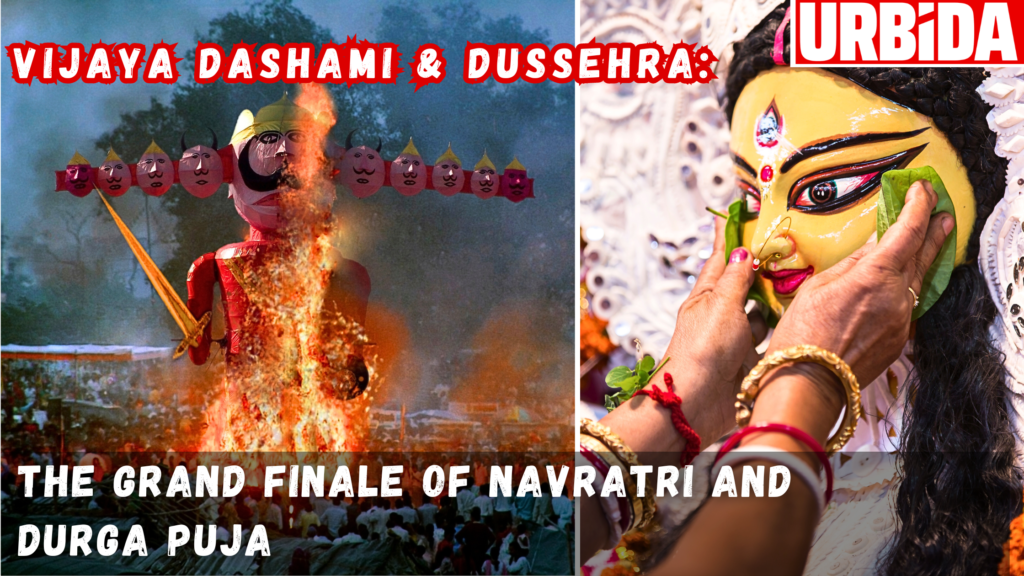
Vijaya Dashami & Dussehra: The Grand Finale of Navratri and Durga Puja
Introduction
India is a land of festivals, where each celebration brings people together in joy, devotion, and tradition. Among them, Vijaya Dashami, also known as Dussehra, stands out as a symbol of victory—celebrating the triumph of good over evil, light over darkness, and truth over falsehood. This auspicious day marks the conclusion of both Navratri and Durga Puja, two of the most beloved festivals in India. For many, it isn’t just a religious celebration—it’s a deeply emotional event, a moment to reflect on the triumphs and lessons of life.
At Urbida, we celebrate this spirit with passion, believing in the power of reinvention and positivity. Much like how Maa Durga’s divine energy inspires resilience and strength, our quirky graphic tees resonate with those who believe in expressing their inner vibe unapologetically. Let’s take a closer look at what Vijaya Dashami and Dussehra represent and how these festivals are celebrated across India.
What is Vijaya Dashami?
Vijaya Dashami translates to the “victory on the tenth day.” The day commemorates the victory of Maa Durga over the demon Mahishasura and, in parallel, the slaying of Ravana by Lord Rama in Hindu mythology. It symbolizes how courage and righteousness triumph over arrogance and evil.
This final day of Navratri is filled with rituals and heartfelt emotions. For many households, it’s also a day of bidding farewell to Maa Durga as her idols are immersed in water bodies, symbolizing her return to her celestial abode.
How Vijaya Dashami is Celebrated During Durga Puja
In West Bengal and other eastern states, Durga Puja culminates in the emotional farewell of Maa Durga. The rituals on Vijaya Dashami are steeped in devotion and nostalgia.
1. Sindoor Khela: Married women playfully apply vermilion (sindoor) on each other as part of the farewell rituals, wishing prosperity and good fortune.
2. Immersion of the Idol: Devotees carry the beautifully decorated idols of Maa Durga to nearby rivers or ponds for immersion, signifying the goddess’s return to Mount Kailash. This is accompanied by processions filled with music, dance, and chants of “Asche bochor abar hobe” (We will celebrate again next year).
3. Sharing of Sweets: Families exchange sweets to mark the joy of Vijaya (victory) and renew relationships, symbolizing the beginning of a new chapter.
What is Dussehra?
In many parts of India, the same day is celebrated as Dussehra, which narrates the story of Lord Rama’s victory over the ten-headed demon Ravana. It is a grand affair in North India, where cities light up with festivities and Ramlila performances (dramatic retellings of Rama’s life) come to a spectacular conclusion with the burning of Ravana’s effigy.
Dussehra Celebrations Across India:
1. Effigy Burning: In cities like Delhi and Varanasi, massive effigies of Ravana, Meghnad, and Kumbhakarna are set on fire amidst fireworks, marking the end of evil forces.
2. Fairs and Cultural Programs: Local fairs offer everything from street food to carnival rides. Artisans also set up stalls selling handicrafts, traditional outfits, and festive goodies.
3. Exchange of Apta Leaves: In Maharashtra, it is a tradition to exchange apta leaves (believed to symbolize gold) among friends and family to wish prosperity and success.
The Emotional Significance of Vijaya Dashami
Vijaya Dashami isn’t just about rituals. It is about renewal and letting go. As devotees immerse the idols of Durga, it teaches us the beauty of impermanence—reminding us that every farewell holds the promise of a new beginning. It’s a day to reflect on the struggles we’ve overcome, celebrate our victories, and step forward with hope and positivity.
Similarly, Dussehra gives us a lesson in inner strength and righteousness. Just like Lord Rama conquered Ravana, we too can defeat the obstacles within us and emerge stronger.
Fashion Tips to Celebrate Vijaya Dashami & Dussehra in Style
At Urbida, we believe that festive fashion should reflect your personality and spirit. Here are some quick styling tips to look your best during the celebrations:
1. Bright Colors for Festive Vibes: Red, orange, and yellow are colors that symbolize victory, energy, and celebration—perfect for the day!
2. Graphic Tees with Traditional Prints: Mix tradition with modernity. Pair our quirky graphic tees with a dhoti-style pant or ethnic skirt to rock a fusion look!
3. Accessories with a Punch: Complete your look with oxidized jewelry or traditional footwear to strike the perfect balance between quirky and classic.
4. Comfort is Key: If you plan to attend a local fair or be part of the immersion process, go for something comfortable yet trendy, like an Urbida tee with joggers and sneakers.
Conclusion: A Time to Celebrate and Reflect
Vijaya Dashami and Dussehra mark the end of one journey and the beginning of another. They remind us to celebrate not only our victories but also our failures, as they teach us invaluable lessons for the future. Whether it’s the immersive experience of Durga’s farewell or the fiery end of Ravana’s effigy, this day fills every heart with hope, joy, and renewal.
At Urbida, we resonate deeply with the essence of these festivals. Just as Vijaya Dashami marks the victory of inner strength, our clothing brand symbolizes self-expression, authenticity, and individuality. This festive season, celebrate your inner warrior with graphic tees that reflect who you are.
Let’s make every farewell a promise, every victory a new beginning, and every outfit a statement of joy and confidence. Celebrate Vijaya Dashami with Urbida—because your vibe deserves to shine!
Tagline:
Urbida wishes you a joyous Vijaya Dashami and Dussehra! Stay quirky, stay victorious.

